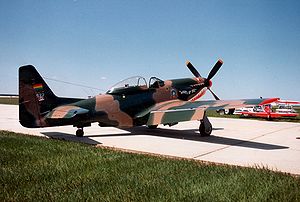Cavalier Mustang Video - At Viareds Airfeild, Sweden Airshow
More Cavalier Mustang Videos 1 - Cavalier Mustang Pictures
|
|
|
|

Role: Counter-insurgency
Manufacturer: Cavalier Aircraft Corporation
First flight: 1971
Retired: 1984
Status: Experimental
Number built: 25+
Developed from: P-51 Mustang
Variants: Piper PA-48 Enforcer
The Cavalier Mustang was a civilian-modified version of the North American P-51 Mustang aircraft.
Development
In 1957, newspaper publisher David Lindsay formed Trans Florida Aviation Inc. His intention was to transform surplus military P-51s into executive business aircraft. These aircraft were initially called the Trans-Florida Executive Mustang, soon renamed the Trans Florida Aviation Cavalier Mustang. The first of the Executive Mustangs was built in 1958 and for the next few years, only a handful of airframes were built and sold.
To construct the Executive Mustang, Trans Florida purchased military surplus P-51s. The airframes were completely disassembled, the military equipment stripped out, and then rebuilt with a second seat, new avionics, plush leather interiors, luggage bays and civilian paint schemes. By 1961, the aircraft were re-named Cavalier 2000, referring to the 2,000 statute mile range. Five different Cavalier models were eventually offered: the Cavalier 750, 1,200, 1,500, 2,000 and 2,500, differing in fuel capacity, with the name indicating the range of the aircraft. Over the course of the next decade, nearly 20 of these aircraft would be constructed. Several FAA approved modifications to the Cavalier design would be made during that time, including canopy frame mounted cockpit fresh air vents, 110-gallon (416 l) wingtip fuel tanks, fuselage baggage door, ammo/gun bay fuel tanks, and a 14-inch (0.36 m) taller vertical stabilizer.
Between 1964 and 1965, Trans Florida completed an IRAN inspection of over 30 F-51Ds of the Dominican Air Force (FAD) in Sarasota.
In 1967 the company was renamed Cavalier Aircraft Corporation.
Military Cavaliers
Cavalier F-51D
In 1967, a decade after creating their first civilian P-51 conversion, Trans Florida was contracted by the United States Department of Defense to create military specification F-51Ds for export. These military aircraft incorporated most of the improved features of the civilian Cavaliers but were optimized as ground attack fighters. These aircraft were called Cavalier F-51D Mustangs; nine single control (F-51D) and two dual-control (TF-51D) aircraft were built. The airplanes were given new 67-XXXXX and 68-XXXXX serial numbers. Nine (including the two TF-51s) were given to Bolivia, under a program called Peace Condor and two, with tip tanks, were sold to the United States Army for use as chase aircraft.
Cavalier Mustang II
In 1967, Cavalier developed an outgrowth of the F-51D designed for close air support and counterinsurgency operations, calling this aircraft the Cavalier Mustang II. The Mustang II had improved avionics, structural improvements to the wing to allow more external weapons carriage on four additional hardpoints and an improved Rolls-Royce Merlin V-1650-724A engine.
Two batches of Mustang IIs were constructed: the first group was built for El Salvador in 1968 and the second group was constructed for export to Indonesia in 1972 and 1973. The five Mustang IIs (including one TF-51D) built for El Salvador featured wingtip fuel tanks to increase combat range. Five Mustang IIs and one TF-51D were built for Indonesia in 1972, but they did not have tip tanks due to a US State Department restriction.
Cavalier Turbo Mustang III
In 1968, Cavalier mated a Rolls Royce Dart 510 turboprop to a Mustang II airframe. This privately-funded prototype was also intended for the same CAS/COIN mission that the Mustang II was built for. The Turbo Mustang III had radically increased performance, along with an associated increase in payload and decrease in cost of maintenance. Despite numerous sales pitches to the US Air Force, neither the US military nor any foreign operators purchased the Turbo Mustang III.
Seeking a company with mass production capability, the Turbo Mustang, now called "The Enforcer," was sold to Piper Aircraft in 1971. Piper was able to lease a Lycoming T-55L-9 engine from the USAF (the engine Lindsay wanted initially) and flew the aircraft the some 200+ hours. In 1984 with a $US12 million appropriation from Congress, Piper built two new Enforcers, giving the new prototypes the designation PA-48. These aircraft were evaluated by the USAF, but flown only by Piper test pilots.
Cavalier closed up shop in 1971 so the founder/owner, David Lindsay, could help develop the Enforcer. A company called Field Services Inc. continued the contract for Indonesia. Many of the civilian conversions, as well as many re-imported former military Cavaliers, have been restored into P-51s and are flying on the U.S. air show circuit today.
Specifications (Cavalier F-51D)
General characteristics
Crew: One
Length: 34 ft 2 in (10.40 m)
Wingspan: 41 ft 4 in (with Tip Tanks) (12.60 m)
Height: 13 ft 1 in (4.00 m)
Wing area: 408 ft² (37.9 m²)
Empty weight: lb (kg)
Loaded weight: 12,000 lb (6,350 kg)
Powerplant: 1× RR Merlin 724 Four blade HS hydromatic, 1720shp (1,831 kW)
Performance
Maximum speed: 440 mph (650 km/h)
Range: 2000 miles (1,480 km)
Service ceiling: 41,000 ft (11,465 m)
Rate of climb: 3,000 ft/min (m/s)
Wing loading: 34 lb/ft² (167 kg/m²)
Power/mass: 0.18 hp/lb (0.29 kW/kg)
Armament
Six underwing hardpoints for a variety of stores 6 .5inch machineguns
Related development
P-51 Mustang
Piper PA-48 Enforcer
Comparable aircraft
Embraer EMB-314 Super Tucano (ALX)
Pilatus PC-9
Bibliography
Darling, Kev. P-51 Mustang (Combat Legend). Shrewsbury, UK: Airlife, 2002. ISBN 1-84037-357-1.
O'Leary, Michael. Mustangs: North American Aviation's P-51: Past, Present & Future, Warbirds International, Summer 2007.
Living Warbirds: The best warbirds DVD series.
Source: WikiPedia